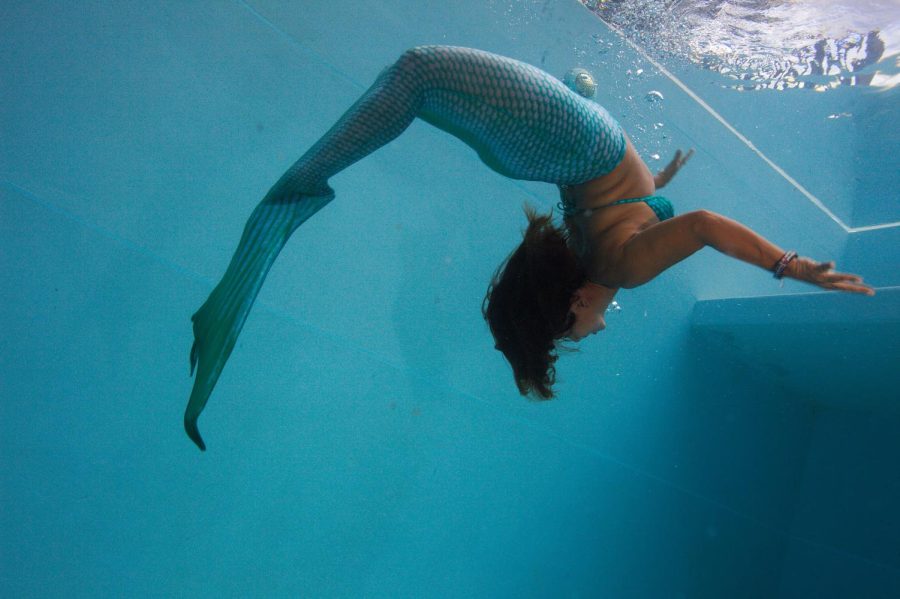Mermaid Madness
Here is a mermaid employee doing a flip (Attribution-Non-Commercial 2.0 Generic (CC BY-NC 2.0)
Their tails shimmering in the light and their long flowy thick hair floating in the water. Their hands pressed against the thick glass walls waving at small children, their eyes enchanted by what they are seeing. But how do they do it? How do they breathe underwater for so long without drowning, or see without goggles? The job of being a mermaid sounds like a fairytale dream more than a career. Gliding through the cool water all day, seeing children’s faces brighten and smiles widen. But how tough is this peculiar job, and how do they execute it?
First thing first, how do they breathe underwater? The mermaids breathe from a hose that is hidden from the audience, usually behind a curtain. They must exhale on the way to the hose or when they get to the hose, to get another breath of oxygen. They must be extremely careful to stay at the same depth or else their lungs could rupture and result in subsequent air embolism. To many people’s surprise, deeper water is okay, while shallow is not. When the mermaids come back to the surface they must exhale the entire journey up, to avoid any problems.

This method of hose-breathing was invented in the 1940s after Newton Perry, a man who had once trained Navy frogmen, bought the famous “Weeki Wachee,” where professional mermaids dance underwater in front of a large audience. The crystal-clear limestone ring was stuffed with trashed kitchen appliances and junky cars. Perry cleared it out to fulfill his odd vision: a place where mermaids could swim. He then explored all kinds of different ways people could inhale air underwater beside the large and unrealistic oxygen tanks on their backs. The hoses he installed, which push air out from a compressor, function similarly to how they did in 1947. In 1959, the company ABC bought Weeki Wachee, and up to half a million people including celebrities like Elvis Pressley and Don Knotts came to watch the mermaids perform. However, today Weeki Wachee Springs is a state park, and the shows typically consist of simple water-choreographed plays, more on the theatrical side.
Besides the lack of oxygen underwater, what other risks do these brave girls take to transform into mermaids consistently? Jim Chimiak, medical director of the nonprofit Divers Alert Network, stated the health risks of staying 20 feet down are minor. The water pressure where the mermaids perform is around 1.5 times the pressure that a body experiences on land, an increase that doesn’t require any decompression. Although divers must take care of their middle ears, which they can easily do by swallowing. “The eardrum, bones of the middle ear, or hearing and balance organs of the inner ear can be injured or permanently damaged otherwise,” he reported. Honestly, the real challenge are the surface problems. The mermaid’s bodies may not restore the natural oils lost while swimming. Cracked or cut skin can lead to infection from any bugs located in the water. The women must stay hydrated as well, as each entrance back into the water will “stimulate a diuresis” or, make them have to pee more. Then there is also “swimmers’ ear”, which can infect even the most casual watergoer. In rare cases, hypothermia is also a problem if the mermaids are swimming in a colder body of water.
Although the physical problems are frightening, the psychological is quite the opposite. Typical synchronized swimmers’ heart rates decrease quickly when they begin to hold their breath, even when exerting themselves. This is their body’s way of tricking them into breathing less. “When the heart rate is lower, it implies that there is less oxygen being needed,” said Teresa Alentejano (world-recognized synchronized swimmer coach and physiology researcher), “and consequently less is being provided.” The mermaids’ ease in the water also helps. A normal person’s “can’t breathe/must breathe” feeling initiates a fear response, which causes the heartbeat to become rapid, and a spiral of despair requires more brain oxygen to fuel panicky thoughts. Alentejano even speculates that because the untrained body can curtail or cease nonessential functions to hoard oxygen for the heart and brain, the synchronized swimmer’s body may have expanded on that, including muscles required for swimming as essential, thus saving oxygen for them.
As interesting as this job seems, how much do the actors really sacrifice to fulfill many children’s dreams of becoming a mermaid? It is not as glamorous as many may believe it is. The women pack on waterproof makeup and slide on their heavy, but beautiful tails. The pay typically starts at about $10 an hour or a few hundred dollars an event. The tryout process is extremely stressful. They happen about once a year, or as needed, and the competitors must swim 400 yards in under 15 minutes. If you do end up qualifying, there is still loads of training, in and out of the water. On top of it all, the water at most mermaid events is pretty chilly.
So, this tough job consists of stressful training, low paychecks, heavy tails, and makeup, health risks, and more, but is it all worth it to see the smiling children with their amazed faces in the crowd, and to be a physical mermaid? That’s up to you to decide.
Sources:
https://www.quora.com/How-do-professional-mermaids-breathe-underwater
https://www.dontwasteyourmoney.com/heres-how-these-women-make-a-living-as-real-life-mermaids/





